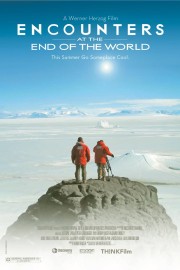Encounters at the End of the World
Madness and magnificence tend to go hand-in-hand in the films of German master Werner Herzog. In “Aguirre, the Wrath of God,” the madness of a selection of Spanish noblemen and soldiers who set off into the Amazon in search of the lost City of Gold that gets amplified by the magnificence of the engulfing jungle around them. In “Grizzly Man,” there’s the madness of a nature-loving environmentalist who thinks he can live among the grizzly bears in Alaska coupled with the magnificence of actually seeing the bears so up-close in their environment. In “Rescue Dawn,” there’s the madness that sets in after being held in a Vietnamese P.O.W. camp for many years deep in the jungle, and the magnificence of the jungle around it, so beautiful to look at, yet so enormous that escape seems impossible. In “Fitzcarraldo,” we find the madness of an opera-lover determined to move a ship across land from one river to the other once again amplified by the magnificence of the Amazon around him. In his documentary “Lessons of Darkness,” these two ideas are difficult to find in any narrative form, but both are encapsulated in the dramatic sights of oil fires in the otherwise stark Kuwaiti desert. Even harder to see them in is his genre film “Nosferatu the Vampyre,” which might explain why that remake of the classic silent masterpiece by fellow German F.W. Murneau is my least favorite of his films. Madness and magnificence seem to be the life force of his greatest films; to imagine a film of his without them at this point- be it documentary or feature film (both of which he’s well adept at making, as the above list proves)- makes the prospect of seeing that film dim somehow.
What Herzog sees at the heart of such stories, and such profound ideas, is insight into the human condition, which seems at its’ essence in the presence of both conditions. In the case of “Encounters at the End of the World,” magnificence- once again, provided by nature itself- is more prevalent than madness is as Herzog, inspired by the pictures taken by a friend of his, travels to Antarctica to explore the unusual beauty of its’ terrain and to probe the minds of the people who make their home there. That isn’t to say that madness doesn’t set in, however; Herzog calls into question the sanity of an unlikely inhabitant in a way that veers towards ridiculousness, but when contemplated further, it does seem like an interesting question.
Herzog’s narration, as always, allows us into the wheels of his psyche, while his interviews allow us access into the minds of the people he finds himself drawn to. At the outset, one might find it odd that anyone would want to make their home on the continent, which Herzog chooses to visit at the time of year when there is no darkness. So when the sundial in the main town says it’s 1am, we can see it clearly, without need for artificial lights of any kind. But while some of the people Herzog interviews do present their own individual quirks, we don’t find anyone quite like “Grizzly Man’s” Timothy Treadwell or “Fitzcarraldo’s” opera lover on the sanity meter. Mostly we find scientists and laborers, drawn to the environment for not just its’ geological and biological wonders, but also for a simple form of life that’s impossible on any other continent. Although at the city of McMurdo, Herzog is disappointed to find an ATM present. Can’t say personally that I blame him.
One of the things you notice right away is that many of the interviewees Herzog chooses, when their job titles come up, they have two. The second one is generally more descriptive of what they do for a living, while the first one speaks towards who they are inside. We have travelers mostly travelers and adventurers of some sort, people drawn towards a way of life where discovery is an essential part of the appeal for them in the lives they’ve chosen. And their personalities show that- there’s no two people in this film that are exactly the same in both their world view or in their passions in life. That’s not to say they have nothing in common in that department- all of them mourn the forces of nature and man that may just lead to our way of life coming to an end in the future, bringing on profound change to the world we inhabit. Herzog shares their bleak outlook. But don’t expect preachiness from Herzog; he’s much more content to present these people, and their way of existence, as a tribute to iconoclasts like him, who are concerned more with the betterment of the world around them than any personal recognition. Such as witnessed by the excitement we feel when biologists who’ve just went underneath the ice discover they’ve found three new types of species in the water below.










